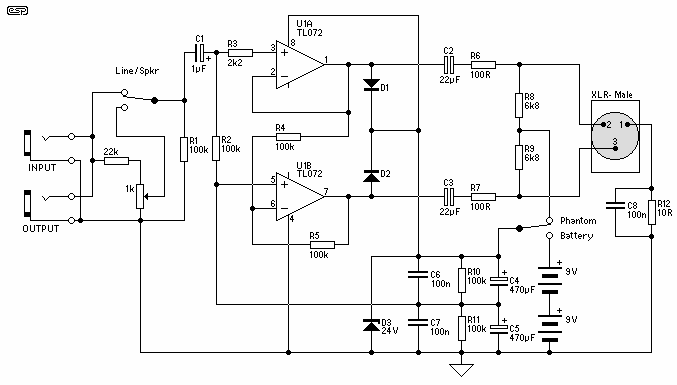

The Unleash and Torpedo Reload perform the reamp function via solid-state power amps, while the Fryette unit features 50 watts of all-tube power. The Bad Cat Unleash, Fryette Power Station, and Two Notes Torpedo Reload are all good examples. Some devices let you load down an amp and then reamp it with a second power amp-all in one unit. Crank your amp to the sweet spot, knock it down to line level, add effects if desired, and then “reamp" the whole thing to any volume through a power amp and cab of your choice. Think of a load box as the most basic form of attenuator, one that lowers your amp's output to line level.Ī load box can also send the loaded-down line-level amp signal to a second power amp, giving you total control over your tone and volume. Good IRs sound startlingly close to the real miked cabs.
Reamp box schematic free#
(Such impulse responses digitally mimic the sounds various speaker/microphone combinations.) There are large libraries of IRs on the market, and you can find many more free online.
Reamp box schematic software#
Some load boxes have onboard speaker simulations, but if not, you can use an analog speaker simulator like the Palmer PDI09, or a software plug-in that hosts impulse responses. Also called “dummy loads," such devices let you take that line out into a computer-recording interface so you can capture and process your amp's sound.īecause guitar speakers are an important component of guitar tone, you usually want to add speaker simulation.

Think of a load box as the most basic form of attenuator, one that lowers your amp's output to line level. Examples of load boxes include the Suhr Reactive Load, Koch Dummybox Studio/PA, and the Two Notes Torpedo Live. This is where load boxes come in: They safely load your guitar amp and allow you to use it in numerous ways with no speakers. You must always have a load of some sort connected to your speaker-out jack, or you can severely damage the amp. But what if you want to use your tube amp with no speaker(s) connected, perhaps for late-night silent recording or practice? The speaker dissipates energy from the amp as sound. When using a tube amp, a speaker is usually connected. Luckily for guitarists, there's a bevy of devices designed to control, capture, and sculpt the tone of any amp. It's an old problem: Guitar amps can be unruly beasts, hard to tame and difficult to mic live and in the studio. And you really want to capture your amp's glorious tone when recording, but you don't want to invest in microphones and preamps, and you don't have an acoustically perfect space to track either. It sounds like a million bucks when it's cranked to its sweet spot, but everyone always tells you to turn it down.


 0 kommentar(er)
0 kommentar(er)
